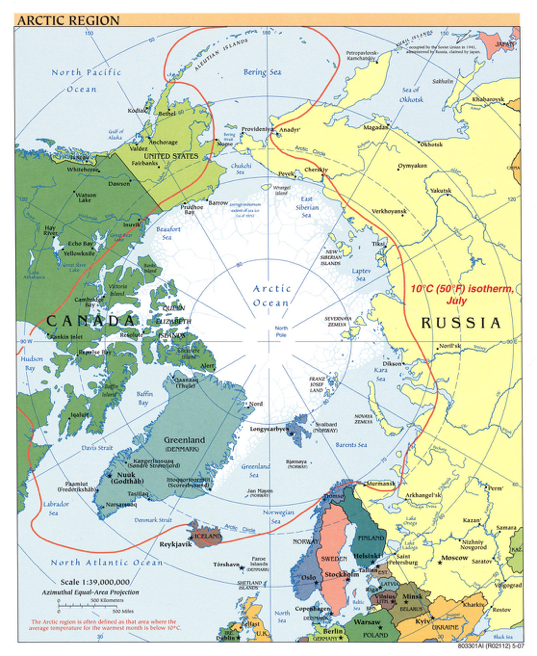April 6, 2018 – Thirty-one miles north of the Arctic Circle lies Kangerlussuaq, Greenland. It is one of the most studied regions in the Arctic. To highlight environmental change and impacts in the Kangerlussuaq area, Arctic, Antarctic, and Alpine Research has released a special issue, to examine how past, present and future climate impacts may affect this landscape.
Image  |
| Arctic Region (Political) map 2007 produced by the U.S. Central Intelligence Agency, scanned version via the University of Texas Libraries. |
Three of the 10 articles currently published and one of the upcoming articles feature lead authors, who are alumni of the Integrative Graduate Education and Research Traineeship (IGERT) at Dartmouth— the National Science Foundation’s flagship interdisciplinary program for educating U.S. Ph.D. scientists and engineers, which has since been retired. From 2008 to 2015, Dartmouth’s Institute of Arctic Studies hosted IGERT and had 25 graduate students participate in the program.
“Dartmouth’s IGERT alumni represent a new generation of Arctic scientists who work across disciplines developing critical research on the Arctic from climate history to land erosion. I am proud of the quality of their scholarship, and their commitment to working collaboratively, a hallmark of the program,” says Ross A. Virginia, director of the Institute of Arctic Studies and the Myers Family Professor of Environmental Science at Dartmouth; distinguished co-lead scholar of the Fulbright Arctic Initiative, 2017-19; and global fellow with the polar initiative at the Woodrow Wilson International Center for Scholars; who served as a co-author on the four papers.
Dartmouth IGERT alumni served as the lead authors of the following articles:
Image  |
| Figure 2 from the study: Photos of sampling locations by Laura B. Levy. (A) Boulder (sample LL1109) on a right-lateral Keglen moraine. See study for full caption. |
- Middle to late Holocene chronology of the southwestern margin of the Greenland Ice Sheet: a comparison with temperature records.
Laura B. Levy, Meredith A. Kelly, Patrick A. Applegate, Jennifer A. Howley, and Ross A. Virginia.
The study explores the rates of ice margin fluctuations in response to climate changes during our current interglacial period (the Holocene; 10,000 years ago to present), which offers insight into how the ice sheet may respond to future climate changes. To do so, they conducted exposure dating of boulders and bedrock eroded by the ice sheet as it retreated. The findings include that ice retreat during the Holocene was likely influenced by warm summer temperatures and that “historical advances of the ice margin occured during the last 200 years, likely in response to cooling temperatures.” Lead author Laura B. Levy, assistant professor of geology at Humbolt State University, is available for comment at: laura.levy@humboldt.edu.
Image  |
| From L to R: Bog blueberry (Vaccinium uliginosum), dwarf fireweed (Chamerion latifolium), and grayleaf willow (Salix glauca). Photos by Christine Urbanowicz. |
- Pollen limitation and plant reproduction across a temperature gradient in western Greenland.
Christine Urbanowicz, Ross A. Virginia and Rebecca E. Irwin.
To understand how climate change may affect pollination and plant reproduction, the study examines three plant species: bog blueberry (Vaccinium uliginosum), dwarf fireweed (Chamerion latifolium), and grayleaf willow (Salix glauca). For the study, the authors acted as pollinators to test the importance of cross pollination by comparing the fruiting success of flowers receiving extra pollen versus control flowers. Adding pollen usually increased fruit production, suggesting that lack of pollinators limited fruit production. They also found that pollinators were better able to keep up with bog blueberry’s demand for pollen in warmer conditions, suggesting that as the climate becomes warmer, blueberry production may be greater due to increased pollination. Lead author Christine Urbanowicz, postdoctoral scientist in environmental conservation at the University of Massachusetts, is available for comment at: christine.urbanowicz@gmail.com. Follow her on Twitter at: @christiurbano.
- Pollen limitation and plant reproduction across a temperature gradient in western Greenland.
Image  |
| Figure 4 from the study by Ruth C. Heindel. Results of M3C2 change detection for the scarp and center zones from two deflation patches, ILSCARP18 (A, C, E, G), and LLGRID6 (B, D, F, H). |
- Quantifying rates of soil deflation with Structure-from-Motion photogrammetry in west Greenland.
Ruth C. Heindel, Jonathan W. Chipman, James T. Dietrich and Ross A. Virginia.
The study examines 10 erosional landforms or deflation patches formed by strong winds blowing off the Greenland ice sheet. It employs Structure-from-Motion photogrammetry, to try and detect changes to these landforms between 2014 and 2016 by creating 3-D models of the landforms. The findings demonstrate that the landforms are actively eroding, which means that this area of Greenland is continuing to lose soil. This could impact vegetation, nutrient cycling and aquatic environments, as eroded soil is blown into lakes and the fjord. Lead author Ruth Heindel, postdoctoral scholar at the Institute of Arctic and Alpine Research at the University of Colorado at Boulder, is available for comment at: ruth.heindel@colorado.edu. Follow her on Twitter at: @RuthHeindel.
- Landscape variation in soil carbon stocks and respiration in an Arctic tundra ecosystem, West Greenland.*
Julia Bradley-Cook and Ross A. Virginia.
The study investigates relationships between soil and vegetation at the landscape scale to understand the sensitivity of soil carbon to environmental change. They found wet grassland soils had 1.7 – 2.3 times higher soil carbon storage and enhanced mid-summer soil respiration as compared to other vegetation types. Although steppe, shrub and mixed vegetation types had lower soil carbon storage, they play an important role in landscape soil carbon storage and dynamics because they collectively cover more than half of the landscape. Environmental trends of increasing temperatures and shrub expansion will likely contribute to a loss of stored soil carbon and increase of greenhouse gases emissions from soils into the atmosphere. Lead author Julia Bradley-Cook, American Association for the Advancement of Science (AAAS) science and technology policy fellow at the U.S. Agency for International Development, is available for comment at: juliabradleycook@gmail.com.
In addition, Ross Virginia is also available for comment on the papers, as well as on other topics affecting the Arctic, at: ross.a.virginia@dartmouth.edu. Follow him on Twitter at: @RVirginiaPolar.
Hi-res images from each of the papers are available and can be obtained from the respective lead author.

